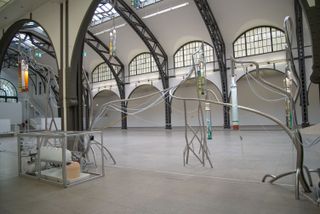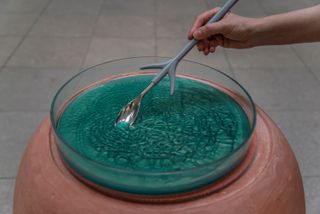A dozen casually dressed performers animate Hamburger Bahnhof’s central hall, leading visitors around the curious topography as they stage a series of live tableaus or vignettes – regularly punctuated by polyphonic singing and semi-poetic speech. An imposing sand dune has been implanted into the space, and a few of them stand atop it, grasping at handfuls as if in search of something. Their actions are not frantic, but precise and methodical. One of them suddenly abandons the excavation project and begins to slowly roll down the side of the dune. Reaching the bottom and continuing to roll across the floor, they are eventually picked up by two others, carried ceremoniously up a winding ramp and set atop a raised platform next to a prominently displayed agate stone. The person and the large stone appear on the same level, and a kind of duet between them begins, enhanced by the sound of another performer humming a short Bach excerpt.
Alexandra Pirici’s ‘Attune’ at Hamburger Bahnhof, Berlin

(Image credit: Courtesy of the artist and Audemars Piguet)
This is just one small part of Alexandra Pirici’s Attune, the artist and choreographer’s largest work to date, co-commissioned by Hamburger Bahnhof and Audemars Piguet Contemporary, which supported the project from its inception. In the buttressed hall of the former train station, with its impressive windowed-wall as a backdrop, Pirici has created what she describes as an itinerary or parcours that feels like a landscape. Performers will activate the space for four hours each day of the exhibition’s run, with a choreography that loops three times over. Most elements of the action are fixed, but some remain fluid and subject to the performers’ improvisation and consonance with one another.

(Image credit: Courtesy of the artist and Audemars Piguet)
However playful or abstract Pirici’s choreographies may appear, they are often grounded in extensive research and a desire to address urgent political questions. For her, rigour and playfulness are not rigidly distinct artistic methods: the success of Attune lies in the solidarity it creates between storytelling and scientific inquiry.
Pirici explains that she ‘intended Attune to be a celebration of the continuum between the animate and the inanimate… I believe that continuum should be celebrated because it literally situates us within the larger fabric of the world, made of the same matter, belonging to the same universe.’

(Image credit: Courtesy of the artist and Audemars Piguet)
Attune stresses the importance of listening to different voices, both human and non-human. The polyphonic chorus, inspired by Georgian or Corsican folk songs, fills the vast space and draws visitors into a meditation on the necessity of acknowledging our place in a multi-perspectival world. Polyphony, Pirici notes, is challenging for the modern ear, which is so focused on the individual voice – it takes a considered level of engagement to both perform and distinguish the multiplicity of voices.

(Image credit: Courtesy of the artist and Audemars Piguet)
The sound of the performers singing also occasionally intervenes directly in the chemical processes taking place on the stainless-steel installation mounted in the space, which Pirici has dubbed the ‘Organ’. Referencing its part in a larger system, or organism, as well as its resemblance to the musical instrument, this vegetal-like structure has glass cylinders hanging from its branches, which contain different experiments. As the performers sing their ‘Organ songs’, the colour and composition of the substances changes, adding another layer to the interspecies collaboration at work in the piece.

(Image credit: Courtesy of the artist and Audemars Piguet)
Placing human bodies in direct dialogue, or chorus, with organic and inorganic matter, Attune draws our attention to the self-organising impulses that exist, not just in human communities but also, and importantly, among seemingly inert materials. By paying attention to the capacity of our surrounding environment to be both active and creative, we can gain a renewed sense of our own propensity for cooperation. Attune, Pirici insists, presents us with an ‘invitation to harmonise’.

(Image credit: Jacopo La Forgia)
Attune, Hamburger Bahnhof, Berlin, until 6 October 2024, smb.museum






